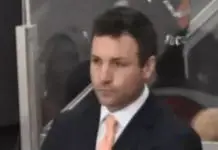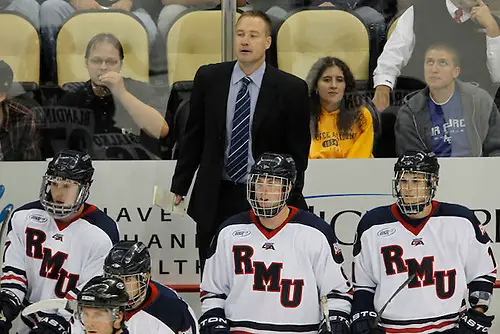
The 2020-21 season was another typical year for the Robert Morris hockey program.
The Colonials won Atlantic Hockey’s Western Pod regular-season championship and were within a game of advancing to their seventh straight playoff semifinal appearance. It took an unorthodox playoff format and a double-overtime second game to stop the team, but RMU clearly ranked alongside American International as the class teams in the conference when it swept the postseason awards.
Nick Prkusic collected the West Co-Player of the Year, and Randy Hernandez was West Rookie of the year. Defenseman Nick Jenny was rated both Best Defenseman and won the Individual Sportsmanship Award within his pod as well, and head coach Derek Schooley, the architect of one of AHA’s most successful programs, won his second Coach of the Year award.
The program was humming along, which is why it was blindsided so badly when the university announced in May that it was ending hockey.
In a flash, one of Atlantic Hockey’s marquee programs was gone, as was College Hockey America’s conference champion women’s program. A hockey hotbed was now without one of its most identifiable assets, and nobody really knew why.
The reasons for RMU’s erasure are still unclear, but there are signs the Colonials’ dismissal will only be a temporary pause. Neither RMU’s men’s team nor its women’s program will suit up this year, but the athletics department, in conjunction with the Pittsburgh College Hockey Foundation, is halfway to its goal of raising $3 million to reinstate a sustainable program. There is hope on the horizon, even if over $1 million in goals still need to be met by December.
But the Colonials’ absence will remain conspicuous at a time when some college hockey programs are in a transitional state. RMU was the third program to either disband or suspend its team during this offseason after contraction initially hit the programs at Alaska Anchorage and Alabama Huntsville, and while each have different circumstances, the notable outcomes have led to the need for more awareness about each individual situation.
“The sustainability of programs is important and actually more important [than just adding teams],” said Mike Snee, the executive director of College Hockey, Inc. “We don’t want to have a one step forward, one step backward type of plan. College hockey is what it is because all of the current programs contributed history, and that’s what makes it so exciting. It brings out the passion of the fans, and when programs are dropped or threatened, sustaining growth [in all teams] is the more important part.”
Hockey is a difficult sport to pursue for any program, but its hurdles and expenses are well known at a surface level. Rinks and arenas require specialized overhead for a sport that doesn’t have the same widespread, simplistic appeal as football or basketball, a combination that resulted in a smaller sport situated predominantly in the hockey regions ranging mostly from Minnesota to New England with conferences that aren’t the widely-recognized, all-sports leagues.
The expenses are a very real conversation, and it was a big reason why the programs in Alaska and Alabama were left exposed during the latest round of realignment. Membership in the same conference stretched a centralized, Minnesota-Great Lakes-Midwest league over 4,000 miles and created fault lines, and the fissures revealed themselves every few years whenever conferences shifted along their tectonic plates.
“Budgets had to be bigger because it costs what it costs,” said Dr. Cade Smith, the athletics director at Alabama Huntsville. “[Nobody] did any ridiculous things to spend money, but this cost a lot to have it to play where we played, just as it costs what it cost to play soccer. We weren’t wasting money, but the reality of our budget is that a big part of our budget was for hockey. I think I was able to appreciate how well everyone managed their budget [when the team was active].”
It became too much for their leagues to endure, and this year, the CCHA formed when seven WCHA schools broke away and effectively marooned the two Alaska schools and Alabama Huntsville onto their own islands. It wasn’t the first time those three schools endured a conference breakup, but the WCHA/CCHA merger following the formation of the Big Ten and NCHC was significantly different for each school.
Alabama Huntsville, for example, was left without a dance partner when College Hockey America collapsed in 2010. The league only had four teams left in its final year, but Bemidji State’s transfer to the WCHA and Robert Morris and Niagara’s realignment into Atlantic Hockey left the Chargers without a conference. That lack of a league was then the mitigating factor in the university’s decision to drop hockey in 2012.
The program survived because of its donors, who offered a stay of execution long enough for UAH to join the new WCHA when the Big Ten and NCHC gutted both the WCHA and CCHA. The lifeline, though, came with a major geographical issue because Alaska was joining Alaska Anchorage in the same league, and it was the first time teams from The Last Frontier were in the same conference since the Great West Hockey Conference experiment of the 1980s.
A nightmare scenario immediately arose, but it was somehow avoided since none of the teams ever made the eight-team postseason in the same year. Huntsville never had to travel to Alaska or vice-versa on short notice, and the only time any of those teams ever hosted a playoff series was the league’s first year when, ironically enough, sixth-seeded Anchorage traveled to third-seeded Fairbanks.
Avoiding that scenario came with its own caveat, though, because the three teams never won enough to earn a coveted home spot. The travel made things exceptionally more difficult than the localized teams, and it formed another crack when the WCHA’s top tier failed to send more than two teams to a national tournament. Only one team qualified in 2016 and 2017, and it took Bowling Green’s last at-large, bubble spot in 2019 to ensure a second bid for that season.
Everything kept compounding, and in February, 2020, the seven schools from the Central United States announced their intention to form a new league with Alaska, Alaska Anchorage or Alabama Huntsville. The powder keg exploded, and the three schools thrown a life preserver by the merger of the WCHA and CCHA ended their 2019-2020 season without a home after the 2020-2021 schedule.
But everything exploded even worse when COVID-19 broke out one month later. Issues around travel and expenses all of a sudden transformed from tightropes and problems to outright disasters, and universities everywhere felt an immediate tightening as the pandemic gripped the nation.
“In the spring of ‘20, when COVID and everything else happened, there were a lot of things going on where we were trying to figure out where we could save expenses,” Smith said. “We knew it wasn’t looking all that promising for us with the seven schools that left [the WCHA], and that was one thing that we talked about at the time, and that led us to the ultimate decision to discontinue the program.”
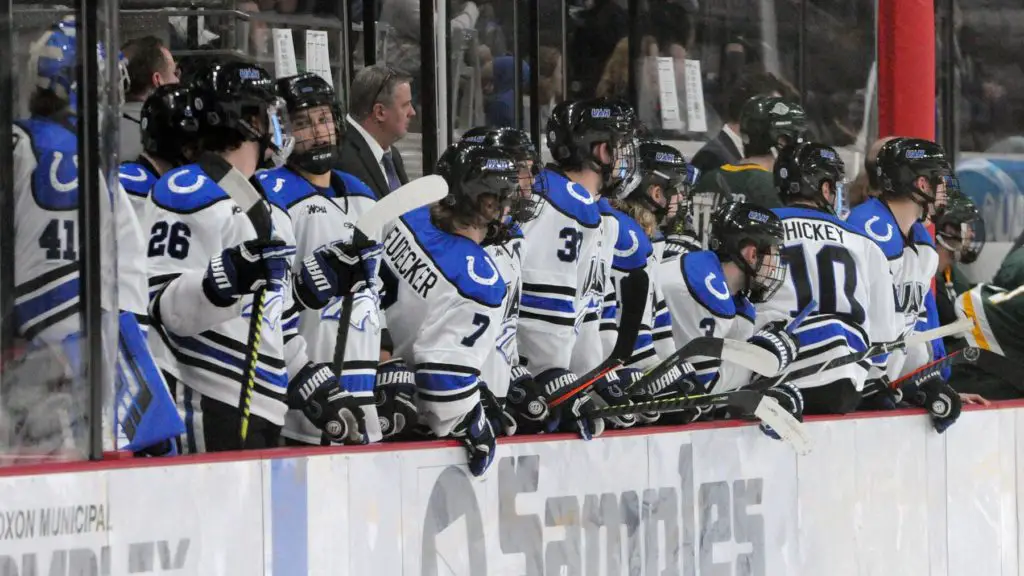
All three programs were forced to deal with their own dire straits, but it came during a particularly-severe downsize in Alaska. Funding to the university system was down 40 percent, and the quagmire resulted in a board of regents vote to put it in “financial exigency.” The 10-1 decision freed up the state to fire tenured faculty and other staff while enabling the ability to shutter whole programs as part of a larger, $130 million cut by the governor’s office.
Hockey was placed right in the crosshairs, and even after saving $200K by moving into an on-campus home, the overall situation surrounding funding and a league home led Anchorage to announce it would end its hockey program after the 2020-2021 season. But in the fall, as COVID-19 ravaged its way across the United States, even that became too much of an ask, and Alaska Anchorage, along with Fairbanks, opted out of last season.
It was a perfect storm, but like UAH, UAA donors and boosters stepped up to the plate to save their respective programs. The board of regents offered Anchorage a path to reinstatement if fundraising could raise two years’ worth of expenses by February of this year, and after the Save Seawolf Hockey movement started breathing life into the program, the NHL’s Seattle Kraken stepped up its support. The deadline was extended into August, and at the end of the month, the Seawolves were successfully reinstated as an independent program for the 2022-2023 season.
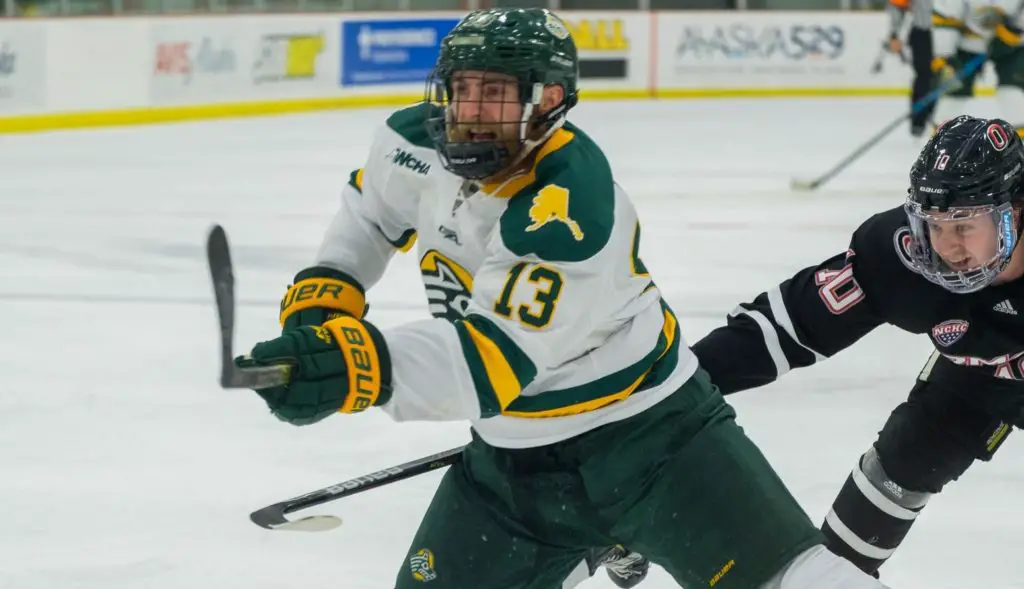
UAA athletic director Greg Myford could not be reached for comment, but in the team’s formal reinstatement announcement on August 31, he said, “Today is about much more than dollars raised. It’s about hope restored and dreams realized. While the financial support is important and necessary, our community of supporters refused to let the vision for Seawolf hockey fade. A mighty thank you to all who contributed to this day.”
Playing as an independent, though, was not good enough for Alabama Huntsville, which had played without a conference in the interim period between its CHA and WCHA eras. It had to find a home, and after the Chargers opted into the 2020-2021 season, they sought to save their team by applying to both the new CCHA and the 11-team Atlantic Hockey league based out of New England and the greater New York/Western Pennsylvania area.
“We had a pretty good week of fundraising with our donors and supporters and basically bought a year in order to try and find a conference home,” Smith said. “That fundraising – the GoFundMe and everything that people were familiar with – gave us time to try and find a conference home. The two options that were possible were the new CCHA, which I don’t know was named that at the time, and then obviously Atlantic Hockey.
“By the time we got to January, we were ready to submit an official proposal to the Atlantic,” Smith said. “That was after a lot of conversations with [league commissioner Bob Degregorio] and other folks. We made two proposals in the spring. The CCHA got back to us really fast, but Atlantic took a while because [expansion] was not a big focus with everybody trying to finish the season and manage COVID. When we finally got an answer in June, the writing was on the wall for what we knew the answer was going to be. We had a bunch of players that were here, and so we made the decision in the spring to suspend about a month before we found out officially from Atlantic Hockey.”
This was the maelstrom engulfing college hockey when Robert Morris mercurially ended its hockey program in May. It made no sense at the time because the Colonials were a healthy, championship program with a history of dominating Atlantic Hockey. They owned their own arena and won every piece of hardware possible over the last decade, and their built-in rivalries with several teams built support through the highest levels of a hockey-rabid market in Pittsburgh, Pa.
Their popularity made RMU a common name in the non-serious, water cooler talks around league expansions, and the CHA champion women’s program complemented the men’s team perfectly – and vice-versa. Brianne McLaughlin, a 2009 graduate of the team, was a two-time silver medalist at the Winter Olympics with Team USA, and more than a few men’s players reached the AHL at a time when that wasn’t commonplace in Atlantic Hockey.
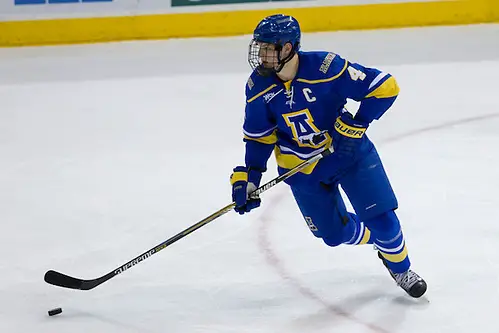
Yet there was the announcement on May 26 that both teams were being dropped as part of “a series of strategic initiatives intended to position the university to be among the most agile and professionally-focused schools in the nation.” It made no sense and, to a large degree, still doesn’t.
“It’s been a roller coaster, for sure,” athletic director Chris King said in a September, 2021 article by DK Pittsburgh Sports. “I don’t know of any Division I athletic director who ever wants to be part of discontinuing sports, and it’s a tough, tough situation because you kind of feel like you’re switched on, you’re in the middle.”
King wasn’t available for comment for this post, but the article in DK Pittsburgh Sports noted that the announcement to end hockey came from an administrative level. His athletic department, it said, had its budget balanced during the pandemic, and RMU clearly wasn’t facing the same dire situation as the other two universities.
It didn’t stop RMU from the same fate, though, and the Colonials entered the college hockey cycle of grieving when dismayed social media offered varying levels of anger and sadness.
A GoFundMe, a common response to a program cut in the modern era, quickly formed, but the movement grew almost immediately into the Pittsburgh College Hockey Foundation. It formalized the effort and linked up with King and the athletics department, and within five months, nearly 500 season tickets were sold for programs that didn’t have a formal future.
“Without even having a team to sell tickets for, [nearly 300] of those are men’s tickets,” Derek Schooley, the men’s hockey coach and director of operations for both the men’s and women’s programs said. “You throw those in with our donor club of 200 people and our player comps, and you’re getting close to 80 percent capacity before we ever put individual game tickets on sale. That’s outstanding. The university has made Hockey is the Goal one of its top fundraising priorities. Everybody’s focused on doing the work to raise the money and keep visibility up, and I think you’re going to see some events moving forward [that will help].
“The most important thing is that we show that there’s a lot of support for Division I hockey at Robert Morris,” he said. “We’ve raised approximately $1.4 million in gifts and pledges towards the return, but we still have a steep climb to reach our goal of $2.8 million. But with those gifts and pledges, we’re taking the necessary steps to return to the ice and hit that target.”
It was the latest attempt by fans, supporters and the college hockey community to save a program, and while each of the three teams got to this point with completely different avenues, they each reinforced how the community and the fans could at least force a university to analyze why hockey became unsustainable. In all three cases, the universities admitted that it wouldn’t bring a sport back without some level of sustainability, and it was part of the larger conversation when St. Thomas reclassified to Division I and when Augustana broke ground on its arena on Tuesday afternoon.
There are still questions facing the programs. UAH is technically suspended but won’t return unless the situation is the right reboot for the athletics department, and both Alaska schools are currently navigating the murky independent waters. The Nanooks successfully compiled a competitive schedule with over a dozen home games, but eight of those games are against either RPI or Clarkson. Alaska Anchorage won’t return until next year and will need to find a new head coach after losing its head coach just before the announcement of a return.
RMU, meanwhile, re-hired Schooley, the only head coach in its men’s program’s history, as its continued leader and hired McLaughlin as its Special Assistant for Hockey Operations. Atlantic Hockey hasn’t yet made a formal announcement and couldn’t be reached for comment, but the widely-held, common sense response is that the Colonials should and will rejoin the league.
Whatever winds up happening, though, the support at the grassroots level is an undeniable, hallmark staple of college hockey. No program wants to rely on it for survival, but it’s showing itself why fans hold the red button. WIthout them, these programs would just fall back into the ether, but instead, they are in the conversation, just like they always were and, in a sense, always will be.
“Other sports compete, for the most part, in their multi-sport conference,” Snee said, “and because of that, organizations like College Hockey, Inc. don’t exist for those sports. They don’t get what I would call an advocacy organization or an advocacy lobbyist organization, and they don’t exist for other, ‘regular’ sports. Football and basketball don’t need it, but every other sport would benefit from organizations like College Hockey, Inc. that just make sure that our sport is growing.”
“We have had tremendous support,” said Schooley. “Everybody’s been great, especially Mike Snee [from College Hockey, Inc.] down to every individual coach and junior coach and even at higher levels in the NHL. We’ve had tremendous support in fundraisers that we’re doing to move forward. Everybody is banding together just like they were with Huntsville and Anchorage to try and save college hockey programs. We can’t afford to lose programs, and I’m thankful for the support.”
“College hockey has always been a sports-specific conference situation,” Snee added. “It has its benefits and negatives, but the benefits build community amongst the schools. One thing that College Hockey Inc. has been able to do is say if [teams] are part of a plan. We can tie every school in college hockey together, whether it’s Division III, Division II, or Division I, if a program has a huge promotion budget or whether they have no promotion budget. Internally, we call ourselves a PR department for college hockey, so when there is something like what happened with those schools. We’re not tied to any one conference, so if you play college hockey, we consider you part of what we can oversee and promote.”

